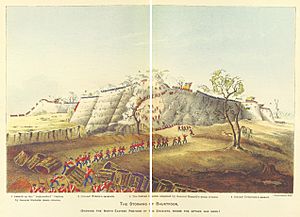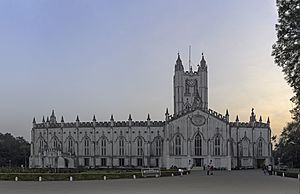William Nairn Forbes facts for kids
William Nairn Forbes (born April 3, 1796 – died May 1, 1855) was a talented British architect and military engineer. He worked for the Bengal Army in India. Forbes is most famous for designing the beautiful St Paul's Church, Calcutta, which is now a grand cathedral in Kolkata, India. This church was built between 1839 and 1847.
Forbes's design for the church's tall spire and central tower was inspired by Norwich Cathedral in England. After two earthquakes in 1897 and 1934 damaged the tower, it was rebuilt to look like the "Bell Harry" Tower of Canterbury Cathedral. This famous tower was designed by John Wastell.
In 1831, Forbes also designed the Calcutta Silver Mint. He used the ancient Parthenon in Athens, Greece, as his inspiration for its grand entrance.
Early Life and Learning
Where Was William Forbes Born?
William Nairn Forbes was born in Blackford, Aberdeenshire, Scotland. He was the sixth son of John Forbes.
How Did Forbes Get His Education?
William was mostly taught at home by a private teacher. For two winters, he studied mathematics and natural philosophy (which is like science today) at King's College, Aberdeen. He was very good at building model machines from a young age.
In 1811, he went to the University of Edinburgh. There, he continued to study mathematics and natural philosophy. He learned from famous professors like John Playfair and John Leslie.
Forbes's Military Training
From 1812, Forbes attended the East India Company Military Seminary at Addiscombe. This was a special school for future officers of the East India Company's army. In 1813, he graduated with high honors. He even received a set of mathematical tools for his excellent results! After this, he joined the Royal Engineers in Chatham, England. He was soon noticed for his skills and joined the Trigonometrical Survey, mapping parts of Wales and Shropshire.
Forbes's Career in India
Starting Work in India
In 1816, Forbes became an ensign and moved to India. He joined the Bengal Engineers, a part of the Bengal Army. He was later made the Surveyor of Embankments in Bengal and Orissa. In 1818, he became a lieutenant. That same year, the Governor-General of India, Francis Rawdon-Hastings, 1st Marquess of Hastings, asked him to design a cathedral church for Calcutta. However, this first design was never built.
Building the Calcutta Mint
In 1819, Forbes went back to Britain to oversee the making of new machines for the Royal Mint in Calcutta. He returned to India in 1823 with the new tools and parts. He was then put in charge of building the new mint as the "Superintendent of the Mint Machinery." Forbes also wrote a report about keeping the channel between the Hooghly River and the Ganges open for boats.
Forbes's Role in the Siege of Bharatpur

In 1825, Forbes asked to join the Siege of Bharatpur, a military battle. His request was approved. During a scouting mission, he broke his right arm and two ribs! Despite his injuries, he was key in preparing large mines that blew holes in the city walls, helping the army storm Bharatpur. The commanding officer, Stapleton Cotton, 1st Viscount Combermere, praised Forbes, calling him "a first-rate Officer of Engineers." After the battle, Forbes went back to work at the mint. He was promoted to captain in 1827.
Designing the New Silver Mint
In 1831, Forbes designed a new building for the mint, known as the "Old Silver Mint." He designed it in the popular Greek Revival style. In 1832–33, Forbes helped survey a route for a canal between Rajmahal and Calcutta. He became the Master of the Calcutta Mint in June 1836. He was promoted to major in 1839.
Constructing St Paul's Cathedral
In 1839, construction began on Forbes's designs for St Paul's Cathedral, Calcutta. He had prepared these plans at the request of Daniel Wilson, the Bishop of Calcutta.
Forbes was promoted to lieutenant-colonel in 1841. In 1847, the year the cathedral was finished, Forbes temporarily served on the Military Board. He had put a lot of effort into the cathedral project, in addition to his regular duties. In December 1847, Forbes was sent back to Britain to join a committee looking into how the Royal Mint was run. He returned to the Calcutta mint in April 1849 and stayed there until 1854. He was promoted to colonel in 1852.
Forbes was also a member of several important groups, like the Geological Society of London. He was interested in steam power and how to improve drainage in cities.
Illness and Death
In 1854, the year he was promoted to major-general, Forbes started feeling very tired. Even though he had always been healthy, he kept working at the mint and on designs for a new Calcutta Post Office. In November, he had a "spasm of the heart." By 1855, his health got worse, and he had to ask for permission to return to Britain.
Forbes began his journey home on a ship called the Oriental on April 9, 1855. Sadly, he died at sea on May 1, 1855.
A statue of Forbes was placed in the Calcutta Mint by the Government of India. After his death, a monument paid for by public donations was put inside St Paul's Cathedral to honor him.


